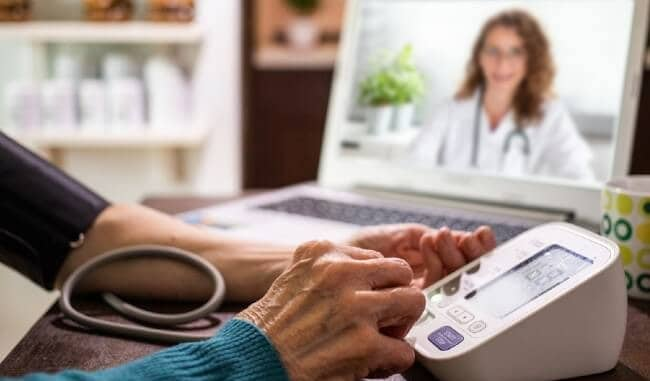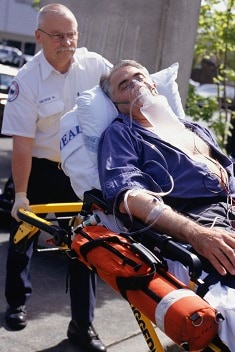Telehealth in Rural Communities
How CDC Develops Programs That Deliver Care in New Ways

People who live in rural areas of the United States are more likely than urban residents to die prematurely from five of the leading causes of death: heart disease, cancer, unintentional injury, chronic lower respiratory disease, and stroke.
CDC’s National Center for Chronic Disease Prevention and Health Promotion uses several approaches to help improve the health of rural residents. One approach is telehealth, which is the delivery of health care through technology such as mobile phones or computers. It can help reduce barriers to care for people who live far away from healthcare services and specialists, who have time or access restrictions, or who have transportation or mobility issues.
Telehealth can be an effective approach for communication and counseling. It’s also a good way for doctors to monitor their patients’ chronic conditions, like heart or lung disease. Better monitoring can improve patients’ quality of life and reduce hospital admissions and deaths from chronic diseases. In addition, telehealth is a good way to deliver care quickly in an emergency, such as a stroke.
CDC is supporting telehealth projects across the country to give rural residents better access to chronic disease prevention and management programs and specialist care:
Stroke Care and Cardiac Rehabilitation
CDC’s Division for Heart Disease and Stroke Prevention promotes the use of telehealth as a way to reduce heart disease and stroke risk factors in rural areas. A recent study looked at the use of telestroke services, which use videoconferencing to connect specialists in stroke centers to health care providers in smaller hospitals with fewer resources. The study found that these services had increased significantly during 2008–2015, especially in rural areas. Telestroke services help increase the use of lifesaving treatments, such as ensuring that stroke patients get a clot-busting drug called alteplase within the national standard of 60 minutes of arriving at the hospital.

Grantees in CDC’s Paul Coverdell National Acute Stroke Program are working to help rural hospitals develop partnerships with hospitals that have telestroke capacity to improve outcomes and reduce deaths. The Coverdell Program is also collecting information to better understand the current use of telestroke services in hospitals and its potential benefits.
Cardiac rehabilitation—or cardiac rehab—is a prevention program that typically occurs in an outpatient hospital facility. It is designed to help patients improve their heart health after a cardiac event or procedure and prevent future events. Rural residents may have trouble participating in cardiac rehab because they cannot afford copayments, lack transportation to a facility, or do not live near a program.
Home-based cardiac rehab, alone or in combination with facility-based rehab, could help rural residents overcome some of these barriers. It typically involves smart devices and apps that allow doctors and other clinical staff to interact with patients and supervise them as they exercise in their homes or community fitness centers.
Evidence has shown that the safety and effectiveness of home-based cardiac rehab is equal to the care delivered in facilities. Million Hearts® is a national initiative co-led by CDC and the Centers for Medicare & Medicaid Services to prevent 1 million heart attacks and strokes within 5 years. Its priorities include increasing the use of cardiac rehab. One component of this effort is the Cardiac Rehabilitation Change Package for health care providers, which advocates home-based cardiac rehab or a hybrid model of facility-based and home-based rehab.
Diabetes Management and Type 2 Diabetes Prevention

In the United States, 37.3 million people (about 1 in 10) have diabetes. Rural populations have higher rates of diabetes and lower rates of participation in diabetes self-management education and support (DSMES) services compared to residents of urban areas.
DSMES services help people manage their diabetes by eating healthy food, being active, checking their blood sugar, taking medicines, and handling stress. DSMES improves health and reduces diabetes complications and can be cost-effective or cost-saving for employers, insurers, and the US health care system. However, 62% of rural counties have limited access to DSMES services.
Telehealth is an effective way to bridge this gap:
- Telehealth can reach more participants than traditional in-person programs.
- Telehealth technologies are less restricted by distance and time barriers, creating greater accessibility for rural and underserved populations.
- Many service providers offer DSMES services via telehealth.
- Many potential participants have access to the internet or devices needed to use telehealth.
CDC created this guide to support organizations interested in offering DSMES via telehealth. The guide provides practical steps for getting started with telehealth and lists specific considerations for each telehealth technology.
The CDC-led National Diabetes Prevention Program (National DPP) is a public-private partnership working to build a nationwide system to deliver an affordable, evidence-based lifestyle change program to prevent or delay type 2 diabetes. Programs can be delivered in person or online, and online programs allow more access and flexibility. Currently, 159 organizations deliver the lifestyle change program online.
The guide also supports organizations interested in delivering the lifestyle change program via telehealth. The guide provides practical steps for getting started with telehealth and lists specific considerations for each telehealth technology.
To help develop best practices, CDC evaluated organizations’ use of telehealth for delivering the lifestyle change program. These briefs describe program structure, technologies used, and implementation steps along with lessons learned:
Vision Care for People With Diabetes
One complication of diabetes is blindness. CDC funds several telehealth projects to screen for eye disease in rural areas. For example, the University of Alabama at Birmingham focuses on the development of high-quality, accessible, and cost-effective strategies for eye care for at-risk patients. This research seeks to apply and evaluate a telehealth-based detection and management strategy for glaucoma and other eye diseases in patients seen at Federally Qualified Health Centers located in rural Alabama.
Tobacco Cessation

The health of people living in rural areas is affected by tobacco use more so than those in urban and metropolitan areas, often because of socioeconomic factors, culture, policies, and lack of proper health care. The 2019 report Advancing Tobacco Prevention and Control in Rural America summarizes aspects of the rural context that may have implications for tobacco prevention and cessation, as well as evidence-based interventions to address tobacco use in this environment. It was published by the National Network of Public Health Institutes with funding from CDC.
Telehealth programs can provide a variety of tobacco use cessation services, but they often rely on high-speed Internet connections. Unfortunately, only about 60% of residents living in rural or tribal areas have such access, compared to over 95% of urban residents. As a result, the use of telehealth for tobacco control interventions is limited in rural areas.
Strategies that use cell phones are another option for reaching rural communities for tobacco cessation interventions. More than 90% of rural residents own cell phones, with more than 3 in 4 sending or receiving text messages. One way to overcome access barriers is to use mobile-friendly short message service (SMS) texting, which provides a direct, immediate channel to communicate your message to residents who may not have high-speed internet service.
In 2018, CDC and the American Lung Association developed a document called Telehealth as a Vehicle for Tobacco Cessation that explores the barriers to and potential benefits of using telehealth to improve access to evidence-based tobacco cessation services.
Epilepsy Management

In 2015, about 3.4 million Americans had epilepsy. People with epilepsy benefit from regular care by a neurologist, but few neurology practices are found in rural areas. Adults with epilepsy are 5 times more likely to report lack of access to transportation as a barrier to health care than adults without the disorder, likely because of common transportation barriers.
CDC’s Epilepsy Program funds the following telehealth interventions to reduce barriers to care:
Epilepsy self-management programs:
- Project UPLIFT(Using Practice and Learning to Increase Favorable Thoughts) is a program delivered entirely by phone that significantly reduces and prevents depressive symptoms in adults with epilepsy. UPLIFT has been piloted in nine states. Reductions in depressive symptoms among participants ranged from 24% to 43%.
- HOBSCOTCH(HOme-Based Self-management and COgnitive Training CHanges lives) is an evidence-based program delivered primarily by phone that is shown to improve memory and quality of life in adults with epilepsy and memory problems.
Epilepsy telementoring programs:
- Project ECHO (Extension for Community Healthcare Outcomes) connects family practitioners, general neurologists, school nurses, and other providers to epilepsy specialists to improve the care of adults and children with epilepsy. It is supported by the Epilepsy Foundation.